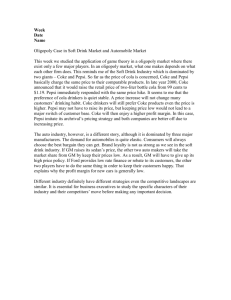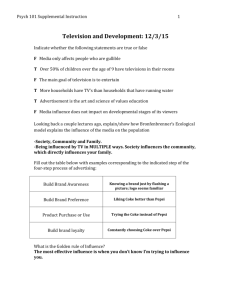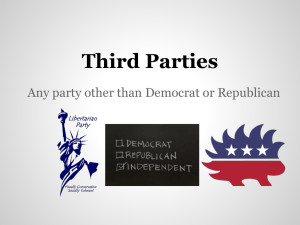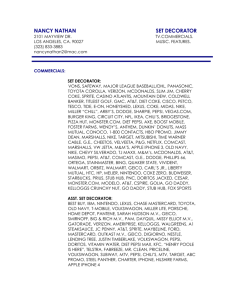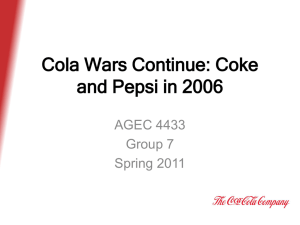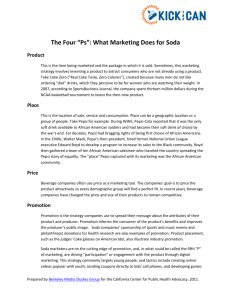Neural Correlates of Behavioral Preference for Culturally
advertisement
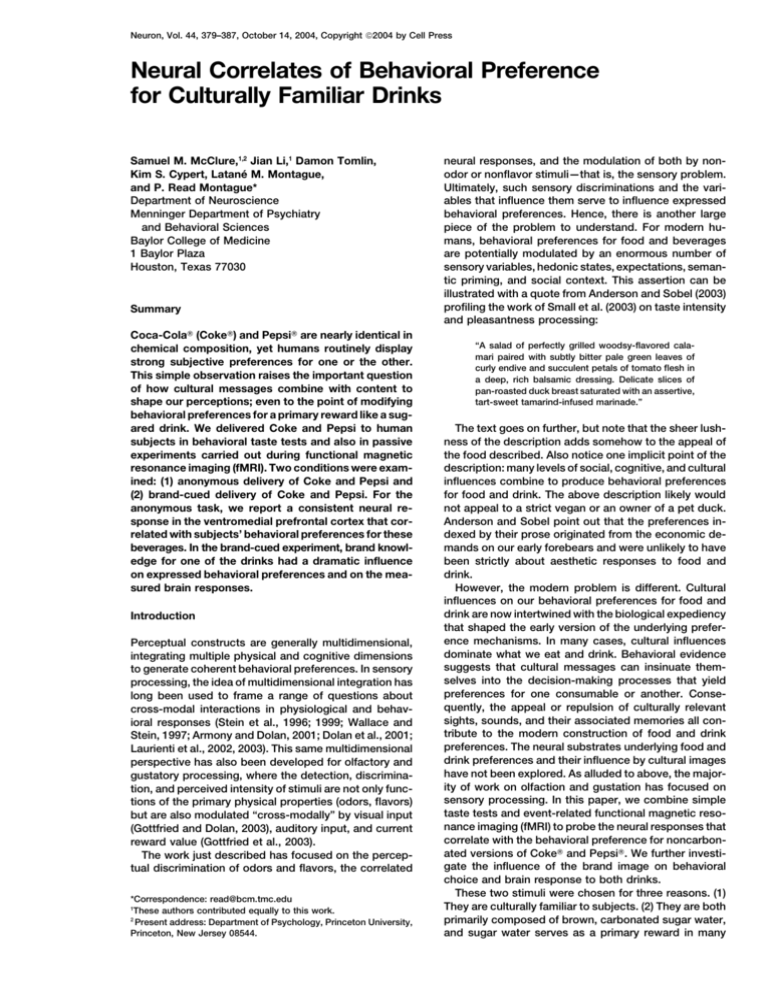
Neuron, Vol. 44, 379–387, October 14, 2004, Copyright 2004 by Cell Press Neural Correlates of Behavioral Preference for Culturally Familiar Drinks Samuel M. McClure,1,2 Jian Li,1 Damon Tomlin, Kim S. Cypert, Latané M. Montague, and P. Read Montague* Department of Neuroscience Menninger Department of Psychiatry and Behavioral Sciences Baylor College of Medicine 1 Baylor Plaza Houston, Texas 77030 Summary Coca-Cola姞 (Coke姞) and Pepsi姞 are nearly identical in chemical composition, yet humans routinely display strong subjective preferences for one or the other. This simple observation raises the important question of how cultural messages combine with content to shape our perceptions; even to the point of modifying behavioral preferences for a primary reward like a sugared drink. We delivered Coke and Pepsi to human subjects in behavioral taste tests and also in passive experiments carried out during functional magnetic resonance imaging (fMRI). Two conditions were examined: (1) anonymous delivery of Coke and Pepsi and (2) brand-cued delivery of Coke and Pepsi. For the anonymous task, we report a consistent neural response in the ventromedial prefrontal cortex that correlated with subjects’ behavioral preferences for these beverages. In the brand-cued experiment, brand knowledge for one of the drinks had a dramatic influence on expressed behavioral preferences and on the measured brain responses. Introduction Perceptual constructs are generally multidimensional, integrating multiple physical and cognitive dimensions to generate coherent behavioral preferences. In sensory processing, the idea of multidimensional integration has long been used to frame a range of questions about cross-modal interactions in physiological and behavioral responses (Stein et al., 1996; 1999; Wallace and Stein, 1997; Armony and Dolan, 2001; Dolan et al., 2001; Laurienti et al., 2002, 2003). This same multidimensional perspective has also been developed for olfactory and gustatory processing, where the detection, discrimination, and perceived intensity of stimuli are not only functions of the primary physical properties (odors, flavors) but are also modulated “cross-modally” by visual input (Gottfried and Dolan, 2003), auditory input, and current reward value (Gottfried et al., 2003). The work just described has focused on the perceptual discrimination of odors and flavors, the correlated *Correspondence: read@bcm.tmc.edu 1 These authors contributed equally to this work. 2 Present address: Department of Psychology, Princeton University, Princeton, New Jersey 08544. neural responses, and the modulation of both by nonodor or nonflavor stimuli—that is, the sensory problem. Ultimately, such sensory discriminations and the variables that influence them serve to influence expressed behavioral preferences. Hence, there is another large piece of the problem to understand. For modern humans, behavioral preferences for food and beverages are potentially modulated by an enormous number of sensory variables, hedonic states, expectations, semantic priming, and social context. This assertion can be illustrated with a quote from Anderson and Sobel (2003) profiling the work of Small et al. (2003) on taste intensity and pleasantness processing: “A salad of perfectly grilled woodsy-flavored calamari paired with subtly bitter pale green leaves of curly endive and succulent petals of tomato flesh in a deep, rich balsamic dressing. Delicate slices of pan-roasted duck breast saturated with an assertive, tart-sweet tamarind-infused marinade.” The text goes on further, but note that the sheer lushness of the description adds somehow to the appeal of the food described. Also notice one implicit point of the description: many levels of social, cognitive, and cultural influences combine to produce behavioral preferences for food and drink. The above description likely would not appeal to a strict vegan or an owner of a pet duck. Anderson and Sobel point out that the preferences indexed by their prose originated from the economic demands on our early forebears and were unlikely to have been strictly about aesthetic responses to food and drink. However, the modern problem is different. Cultural influences on our behavioral preferences for food and drink are now intertwined with the biological expediency that shaped the early version of the underlying preference mechanisms. In many cases, cultural influences dominate what we eat and drink. Behavioral evidence suggests that cultural messages can insinuate themselves into the decision-making processes that yield preferences for one consumable or another. Consequently, the appeal or repulsion of culturally relevant sights, sounds, and their associated memories all contribute to the modern construction of food and drink preferences. The neural substrates underlying food and drink preferences and their influence by cultural images have not been explored. As alluded to above, the majority of work on olfaction and gustation has focused on sensory processing. In this paper, we combine simple taste tests and event-related functional magnetic resonance imaging (fMRI) to probe the neural responses that correlate with the behavioral preference for noncarbonated versions of Coke姞 and Pepsi姞. We further investigate the influence of the brand image on behavioral choice and brain response to both drinks. These two stimuli were chosen for three reasons. (1) They are culturally familiar to subjects. (2) They are both primarily composed of brown, carbonated sugar water, and sugar water serves as a primary reward in many Neuron 380 animal and human experiments. (3) Despite their similarities, they generate a large subjective preference difference across human subjects, which might correlate with fMRI-measured brain responses. We pursued three primary questions using the experiments presented in this paper. (1) What is the behavioral and neural response to these drinks when presented anonymously? (2) What is the behavioral and neural influence of knowledge about which drink is being consumed? (3) In questions 1 and 2, is there a correlation between the expressed behavioral preference and the neural response as measured using fMRI? The medical importance of understanding these questions is straightforward—there is literally a growing crisis in obesity, type II diabetes, and all their sequelae that result directly from or are exacerbated by overconsumption of calories (for recent work see Chacko et al., 2003; Ford et al., 2003; Wyatt, 2003; Zimmet, 2003; Popkin and Nielsen, 2003). It is now strongly suspected that one major culprit is sugared colas (Popkin and Nielsen, 2003). The possibility of obtaining coherent answers to these questions derives from the growing fMRI work on reward processing. Recent work using fMRI has identified reward-related brain responses that scale with the degree to which subjects find stimuli pleasing or rewarding (Knutson et al., 2001; Aharon et al., 2001). With this information in hand, it is tempting to suggest that humans will choose more pleasing stimuli over less pleasing stimuli by evaluation and comparison and that, for our two sugared drinks, the most pleasing drink is the one that subjectively tastes better than its competitor. This perspective offers the simplest model that connects reward-related brain responses to expressed behavioral preferences. However, most real-world settings present numerous primary sensations and top-down influences that act to organize a coherent behavioral preference. Studies have indeed shown that cultural information can modulate reward-related brain response (Erk et al., 2002). This general observation is particularly true for Coke and Pepsi; that is, there are visual images and marketing messages that have insinuated themselves into the nervous systems of humans that consume the drinks. It is possible that these cultural messages perturb taste perception; however, no direct neural probes of this possibility have been carried out. It is this issue and its implications that we sought to address, and our results suggest that there might be parallel mechanisms in the brain cooperating to bias preference. Results A total of 67 subjects participated in the study. They were separated into four groups (n1 ⫽ 16, n2 ⫽ 17, n3 ⫽ 16, n4 ⫽ 18). Each group was given a separate taste test outside the scanner and drink delivery paradigm while in the scanner. For all four groups of subjects, two separate measures of behavioral preferences were obtained. First, subjects were asked “Which drink you prefer to consume: Coke, Pepsi, or no preference?” Their answers are referred to as their stated preferences. Next, subjects engaged in three rounds of a forced-choice taste test (see Experi- mental Procedures for details). In the taste test, the first two groups chose between two unmarked cups, one of which contained Pepsi and the other Coke in a 3-trial and a 15-trial behavioral task, correspondingly (anonymous taste test; Figure 1A). The other two groups (semianonymous taste tests) made three preference decisions, but in this case both cups contained the same drink (either Pepsi or Coke); however, one cup was unlabeled and the other indicated the brand of the drink contained in the cup. In these semianonymous taste tests, subjects were told that the unlabeled cups contained either Pepsi or Coke, and hence no deception was involved. Preferences exhibited during the taste tests are referred to as behavioral preferences. To determine how subjects’ preferences interact with brand information at the level of brain activity, the four subject populations completed scanning experiments analogous to the taste test manipulations. The taste test outside the scanner and drink delivery paradigm inside the scanner are illustrated in Figures 1A and 1B. The design of these experiments was complicated by two facts: (1) blood oxygenation level-dependent (BOLD) responses in reward-related brain areas are significantly affected by whether stimuli are predictable in time (Berns et al., 2001; O’Doherty et al., 2003a; McClure et al., 2003), and (2) we wished to study differential brain responses to soda delivery alone. Because of these constraints, we could not show brand information simultaneous with soda delivery since this would make it impossible to separate the perception of brand information from the response to soda delivery. However, with brand information displayed prior to soda delivery, we had to contend with making the soda delivery predictable. There were two possible strategies: (1) randomize the time between the display of brand information and delivery of soda or (2) construct a design in which brain responses can still be elicited when brain information consistently (fixed time) precedes soda delivery. Since the effect of unpredictability is still a matter of investigation and there is some evidence that brain responses may be elicited in reward-related brain structures based on unpredictability alone (Zink et al., 2004), we opted for the second option. In particular, we adopted the design of McClure et al. (2003) in which strong BOLD responses were elicited even after a large number of event repetitions. We trained subjects to expect Coke and Pepsi at fixed times (6 s) following distinct visual cues (Figures 1B, 4A, and 4C, training period). After training, we then studied brain responses evoked by delayed, unexpected (10 s following cue) cola delivery. For the first and second subject groups (anonymous), the predictive visual cues were flashes of yellow and red light, counterbalanced and paired with subsequent Coke and Pepsi delivery. In the third and fourth subject groups (semianonymous), the two fluids were the same (both either Pepsi or Coke). One of the cues was anonymous (yellow or red light), and the other contained brand information (picture of a Coke can or a Pepsi can; Figures 4A and 4C). In all fMRI experiments in which subjects must swallow, head motion is a concern. Using head constraints, subjects’ head movements remained no larger than 2 mm during the entire experiment. In addition, we performed two separate analyses that both ruled out the Brain Response to Culturally Familiar Drinks 381 Figure 1. Anonymous Coke and Pepsi Task Settings and Behavioral Results (A) Anonymous taste test. Each subject was given a taste test outside the scanner. The test required subjects to make 3 separate choices (groups 1 and 3) or 15 choices (group 2) in which they indicated their preference for the soda in one of two unmarked cups. One of the cups contained 10 mL of Coke, and the other contained an equal volume of Pepsi. (B) In the scanner, subjects were trained to expect soda delivery at a 6 s delay following light illumination using a Pavlovian conditioning paradigm. Twenty light-drink pairings were used for training, separated by random time intervals of between 6 and 16 s. Following training, 6 test pairings for each liquid were randomly interleaved during the succeeding 25 pairings in which soda delivery was unexpectedly delayed for 4 s; evoked brain responses were studied for these 12 delayed deliveries. (C) Correlation of Coke preference in behavioral taste tasks between the original 3 trials and later 15 trials (groups 1 and 3; red; r2 ⫽ 0.51, n ⫽ 15), between first 3 trials and the whole 15 trials in the other independent 15trial anonymous taste test (group 2; green; r2 ⫽ 0.78, n ⫽ 16). (D) Average Coke preference in Coke and Pepsi drinkers in a 15-trial carbonated Coke-Pepsi taste task. Average Coke selection is 7.5 ⫾ 0.8 (mean ⫾ SE) for Coke drinkers and 6.8 ⫾ 0.5 (mean ⫾ SE) for Pepsi drinkers. Our data do not support that stated preference is correlated with behavioral preference in the carbonated state (two-tailed Student’s t test, p ⫽ 0.46, n1 ⫽ 18, n2 ⫽ 18). possibility that any of the following results were contaminated by this possible confound (see Experimental Procedures for more details). First, a two-way ANOVA test of the event-related head movements and six parameters of head movements (x, y, z, pitch, yaw, roll) in all of the four groups was performed. We found that movement was uncorrelated with any event (p ⬎ 0.6 for all movement parameters). Second, in those areas which are identified as “active,” we used head movement parameters as regressors to determine whether their activities were significantly correlated with head movements. This revealed no statistical significance (p ⬎ 0.1 for all movement parameters). All of the subsequent findings relate to brain structures that are not directly involved in processing gustatory stimuli. Therefore, it is important to note that significant brain activity was evoked by the delivery of Coke or Pepsi in gustatory cortical regions (insular cortex; p ⬍ 0.01 for both drinks) but was unaffected by any of our experimental factors. Group 1-2: Anonymous Taste Test The results of the anonymous taste test (3-trial version, group 1) are shown in Figure 3A. A histogram is shown which summarizes the behavioral preferences for all 16 subjects. Subjects were balanced, with a nearly equal number preferring Pepsi, preferring Coke, or showing no distinct preference. Similarly, there was no difference in subjects’ stated preferences (data not shown), with an equal number of subjects declaring a preference for Coke (n ⫽ 7) and Pepsi (n ⫽ 6; p ⫽ 0.79). However, the correlation between subjects’ stated and behavioral preferences does not reach statistical significance (r2 ⫽ 0.14; p ⫽ 0.16). For technical reasons (carbonation builds up in delivery tubes causing unreliable soda delivery in the scanner experiment), all the taste tests were originally conducted with decarbonated soft drinks. However, we now show that the behavioral results are unaffected by carbonation. A separate anonymous taste task of 15 forcedchoice trials was presented to each subject with carbonated drinks (Coke and Pepsi). Stated and behavioral preferences were not correlated in this condition (Figure 1D, two-tailed Student’s t test, p ⫽ 0.46). Behavioral preferences measured in the 3-trial taste task are a potentially unreliable measure of subjects’ true preferences due to the small number of measurements involved in the test. To account for this, we recalled our subjects at a delay of several months and had them repeat the taste test with 15 trials. The outcome of these two separate tests are strongly correlated, as shown in Figure 1C (subjects recalled from groups 1 and 3; red; y ⫽ 3.6x ⫹ 1.5, r2 ⫽ 0.51, n ⫽ 15). Consistency of preferences in 3-trial and 15-trial taste tests was further confirmed within session. In a separate group of subjects (Figure 1C, green), the outcome of their first 3 trials well predicted the outcome of the full 15-trial test (y ⫽ 3.8x ⫹ 2.2, r2 ⫽ 0.78, n ⫽ 16). Group 1-2: Scanning, Anonymous Drink Delivery A linear regression analysis using behavioral preferences from the 3-trial anonymous taste task as a regressor indicated that the difference in brain responses evoked by Coke and Pepsi in the ventromedial prefrontal cortex (VMPFC; MNI coordinates [8, 56, 0]; peak z score 3.44) (Figure 2B) scaled monotonically with the results of the behavioral taste test (Figure 2A) (no other significant regions at p ⬍ 0.001, uncorrected for multiple compari- Neuron 382 Figure 2. Neural Correlates of Preference for Anonymous Coke and Pepsi Delivery in 3-Trial and 15-Trial Anonymous Taste Tasks (A) Behavioral preferences expressed in the 3 trial taste test varied linearly with brain responses in the ventromedial prefrontal cortex (group 1). The vertical axis is the contrast (delayed Coke response ⫺ delayed Pepsi response) for the voxels shown in (B). (B) SPM of neural correlates of behavior preference shown in (A) (thresholded at p ⬍ 0.001; uncorrected for multiple comparisons). (C) Correlation between behavioral preferences expressed in the 15 trial taste and brain responses in the ventromedial prefrontal cortex (group 2). (D) SPM of neural correlates of behavior preference shown in (C) (thresholded at p ⬍ 0.001; uncorrected for multiple comparisons). sons). As with behavioral preferences, the brain response in the VMPFC was independent of the subjects’ stated preferences (paired Student’s t test, p ⫽ 0.87). As with the behavioral results, it is possible that this finding may suffer from noise in our estimates of subjects’ preferences. However, the correlation of BOLD responses in the VMPFC with preference was replicated in the subjects from group 2 whose preference measures were based on 15-round taste tests (Figures 2C and 2D, MNI coordinates [8, 60, 0]; peak z score 3.83; p ⬍ 0.001, uncorrected). The same region of the VMPFC is also significantly correlated with behavioral preference when data from group 1 and group 2 are combined (p ⬍ 0.001, uncorrected for multiple comparisons; data not shown). Individual subjects generally had a strong stated preference for either Coke or Pepsi, and, at any particular time, a guess of which soda they were receiving may have influenced evoked neural responses. The results presented here are not likely to be due exclusively to such top-down influences of brand preference, since stated preference did not correlate with the behavioral preference (taste test results) (r2 ⫽ 0.14). However, to explicitly test for effects of brand knowledge, this influence was directly modulated in the following two tasks. We developed the working hypothesis that the label of either or both drinks would influence the expressed behavioral preference of the subjects. In particular, we tested whether knowledge of which cola was being consumed influenced subjects’ responses. Group 3: Semianonymous Taste Test, Coke As before, three pairs of cups were presented to the subjects. However, in each pair one of the cups was labeled “Coke” and the other was left unlabeled. For the unlabeled cups, the subjects were told that they could contain either Coke or Pepsi. A Mann-Whitney U test showed that the effect of the Coke label was significant when compared with the anonymous taste test, with subjects showing a strong bias in favor of the labeled cup (Figure 3C, p ⬍ 0.05). This was not likely to be a result of spurious subject sampling, because, when the subjects were later asked to complete the anonymous taste test, their results were not significantly different from the group 1 (anonymous) results (Figure 3A, p ⫽ 0.84). Furthermore, these behavioral effects did not correlate with subjects’ stated preferences (p ⫽ 0.92). Group 3: Scanning, Semianonymous Coke Figure 4A shows the stimulus paradigm for the Coke label task. In this condition, one cue was a depiction of a Coke can followed 6 s later by Coke delivery. The other stimulus was a light followed by Coke delivery. The number of cue-drink pairings, the number of catch trials per cue, and the pseudorandom times between pairings were exactly the same as in the anonymous drink delivery task described above (Group 1-2: Scanning; see Experimental Procedures). We contrasted the brain response to surprising delivery of Coke when it was known to be Coke with the surprising delivery of Brain Response to Culturally Familiar Drinks 383 Figure 3. Effect of Brand Knowledge on Behavioral Preferences (A) Histogram of subjects’ preference in double anonymous task. The x axis indicates the number of selections made to Coke (maximum of three). Subjects showed no bias for either Coke or Pepsi. (B) Histogram of subjects’ behavior preference in semianonymous Pepsi task. The x axis indicates the number of selections to the Pepsi-labeled cup. Subjects showed no bias for either the labeled or unlabeled drink. (C) Histogram of subjects’ behavior preference in the semianonymous Coke task. The x axis indicates the number of selections to the labeled Coke. This preference distribution is different from the double anonymous task (Mann-Whitney U task, n1 ⫽ 16, n2 ⫽ 16, U ⫽ 191.5, p ⬍ 0.05) and semianonymous Pepsi task (n1 ⫽ 18, n2 ⫽ 18, U ⫽ 225.5, p ⬍ 0.005), with subjects demonstrating a strong bias in favor of the labeled drink. (D) Average scores of subjects’ preference (number of selections to Coke, labeled Pepsi, and labeled Coke, respectively) in the three behavioral tasks (A–C). Subjects tended to prefer the labeled Coke drink over anonymous Coke (one-way Student’s t test, p ⬍ 0.01). The Coke label had a bigger effect in biasing subjects’ preferences than the Pepsi label (one-way Student’s t test, p ⬍ 0.005). (E) Subjects who participated in the semianonymous Coke task later completed the anonymous taste test. The distribution of people’s preference is significantly different from the Coke-labeled task (Mann-Whitney U test, n1 ⫽ 16, n2 ⫽ 13, U ⫽ 142.5, p ⬍ 0.01) but no different from the results in (A). Coke when it could have been Coke or Pepsi. The results are shown in Figure 4B. Significant differential activity is observed in several brain areas (p ⬍ 0.001, uncorrected): bilateral hippocampus, parahippocampus, midbrain, dorsolateral prefrontal cortex (DLPFC), thalamus, and left visual cortex. Details are listed in Table 1. At p ⬍ 0.005 (uncorrected), the activation in the left hippocampus, left parahippocampus, and midbrain are contiguous (Table 1). BOLD signal changes in the area of the VMPFC identified in the anonymous task were unaffected by brand knowledge (two-tailed paired Student’s t test, p ⫽ 0.96). Group 4: Semianonymous Taste Test, Pepsi The taste test for this group was conducted exactly as for group 3 (semianonymous Coke), except both cups in each pair contained Pepsi, and one was labeled as Pepsi. Again, subjects were told that the unlabeled cup could contain either Coke or Pepsi. Unlike the Coke label, the existence of the Pepsi label did not change the distribution of choices significantly relative to the anonymous taste test (Figure 3B, Mann-Whitney U test, p ⫽ 0.82). Furthermore, selections were biased in favor of the Coke label (in the semianonymous task, above) to a significantly greater degree than they were in favor of the Pepsi label (Figure 3D, p ⬍ 0.005). Group 4: Scanning, Semianonymous Pepsi Figure 4C shows the stimulus paradigm for the Pepsi label task. As with group 3, we contrasted the brain response elicited by the unexpected delivery of labeled versus unlabeled Pepsi. At a threshold of p ⬍ 0.001 (uncorrected), no brain areas showed a significant main effect of brand knowledge for Pepsi (Figure 4D). As in the semianonymous Coke task, activity in the VMPFC did not show a significant effect of brand knowledge (p ⫽ 0.89). Further analysis of the hippocampus and DLPFC revealed that these areas were not significant even at lower thresholds (p ⬍ 0.01, uncorrected). In particular, the p value within the area of the hippocampus identified in the semianonymous Coke task was 0.43, while in the DLPFC it was 0.41. Further, exclusively masking the results in the semianonymous task (at p ⬍ 0.01) with the results from the semianonymous Coke task revealed no common areas of activation. Thus, it seems that brand knowledge for Coke and Pepsi have truly different responses both in terms of affecting behavioral preference and in terms of modifying brain responses. Discussion In these experiments, we used functional brain scanning to find correlates of people’s preferences for two similar sugared drinks: Coke and Pepsi. We report the finding that two separate systems are involved in generating preferences. When judgments are based solely on sensory information, relative activity in the VMPFC predicts people’s preferences. However, in the case of Coke and Pepsi, sensory information plays only a part in determining people’s behavior. Indeed, brand knowledge (at least in the case of Coke in our study) biases preference decisions and recruits the hippocampus, DLPFC, and midbrain. Our results suggest that the VMPFC and hippocampus/DLPFC/midbrain might function independently to bias preferences based on sensory and cultural information, respectively. Neuron 384 Figure 4. Effect of Brand Knowledge on Brain Responses in Semianonymous Tasks (A) An image of a Coke can was used to cue the occurrence of Coke. A red or yellow circle (randomized across subjects) predicted the other. Both sodas delivered were Coke. (B) Coke delivered following an image of a Coke can evoked significantly greater activity in several regions when contrasted against Coke delivered following a neutral flash of light. Significant activations (p ⬍ 0.001, uncorrected) were found bilaterally in the hippocampus (MNI coordinates [⫺24, ⫺24, ⫺20] and [20, ⫺20, ⫺16]), in the left parahippocampal cortex (MNI coordinates [⫺20, ⫺32, ⫺8]), midbrain (MNI coordinates [⫺12, ⫺20, ⫺16]), and dorsolateral prefrontal cortex (MNI coordinates [20, 30, 48]). See Table 1 for details. (C) In the scanner, an image of a Pepsi can was used to cue the occurrence of Pepsi. A red or yellow circle predicted the other soda, and both sodas delivered were Pepsi. (D) No voxels survive p ⬍ 0.001 threshold (uncorrected) for the equivalent contrast in the semianonymous Pepsi experiment. Coke and Pepsi are special in that, while they have very similar chemical composition, people maintain strong behavioral preferences for one over the other. We initially measured these behavioral preferences objectively, by administering double-blind taste tests. We found that subjects split equally in their preference for Coke and Pepsi in the absence of brand information (Figure 3A). The functional brain imaging results corroborate the behavioral taste test results. The BOLD signal in the VMPFC correlated strongly with the behavior results of the double-blind taste tests. This area of the brain is strongly implicated in signaling basic appetitive aspects of reward. Imaging data in healthy subjects indicated with BOLD signal changes scale in the VMPFC Table 1. Location of Brain Areas that Respond Preferentially to Brand-Cued versus Light-Cued Coke Delivery Activations are for the semianonymous (Coke) experiment (p ⬍ 0.001 and p ⬎ 0.005 in parentheses). L, left hemisphere; R, right hemisphere. Brain Response to Culturally Familiar Drinks 385 with reward value (Knutson et al., 2001; O’Doherty et al., 2003b). Furthermore, patients with lesions in the VMPFC are insensitive to future reward or punishment value in making decisions (Bechara et al., 1994). A related brain region, the medial orbitofrontal cortex (MOFC), is strongly related to the VMPFC in terms of function. Our imaging parameters resulted in significant signal loss in this area due to magnetic field inhomogeneities. It remains untested, therefore, whether the MOFC shows preference-related responses The other special characteristic of Coke and Pepsi is that both possess a wealth of cultural meaning. One important fact that may account for the lack of correlation between subjects’ stated and behavioral preferences is the effect of presumed brand knowledge. In accord with this, subjects expressed strong preferences for either Coke or Pepsi when asked which type of soda they normally drink and commonly demonstrated a desire to prove this preference in the anonymous taste test. To test for effects of brand knowledge, we conducted a series of semianonymous taste tests and imaging experiments. In the taste tests, we found no significant influence of brand knowledge for Pepsi contrasted with the anonymous task. However, there is a dramatic effect of the Coke label on subjects’ behavioral preference. Despite the fact that there was Coke in all cups during the taste test, subjects in this part of the experiment preferred Coke in the labeled cups significantly more than Coke in the anonymous task and significantly more than Pepsi in the parallel semianonymous task. The effects of brand knowledge for Pepsi and Coke were reflected in the imaging experiments as well. When an image of a Coke can preceded Coke delivery, significantly greater brain activity was observed in the DLPFC, hippocampus, and midbrain relative to Coke delivery preceded by a circle of light. As with the taste test, equivalent knowledge about Pepsi delivery had no such effect; indeed, no brain areas showed a significant difference to Pepsi delivered with versus without brand knowledge. The hippocampus and DLPFC have both been previously implicated in modifying behavior based on emotion and affect. The DLPFC is commonly implicated in aspects of cognitive control, including working memory (e.g., Watanabe, 1996). Lesions to the DLPFC are also known to result in depression (Davidson, 2002), which is hypothesized to result from a decreased ability to use positive affect to modify behavior (Mineka et al., 1998). It has been proposed that the DLPFC is necessary for employing affective information in biasing behavior (Watanabe, 1996; Davidson and Irwin, 1999). This is consistent with our findings: labeling Coke in taste and imaging tasks both biases behavior and recruits DLPFC activity. Furthermore, both of these effects are lost when compared with the semianonymous Pepsi tasks. The hippocampus has also been implicated in processing affective information, but this association is tied to its role in the acquisition and recall of declarative memories (Eichenbaum, 2000; Markowitsch et al., 2003). The hippocampus is especially important in relating information to “discontiguous” sensory cues, as in the case of our task in which there is a 10 s period (catch trials) between the cue and soda delivery (McEchron and Disterhoft, 1999; Christian and Thompson, 2003). Imaging data indicate that the hippocampus is also im- portant in recalling affect-related information (Iidaka et al., 2003; Markowitsch et al., 2003). Our finding supports these data and suggests that the hippocampus may participate in recalling cultural information that biases preference judgments. Importantly, the hippocampus and DLPFC are only two of several brain areas that have been implicated in biasing behavior based on affect. Other areas include the amygdala, ventral striatum, anterior cingulate cortex, posterior cingulate cortex, and orbitofrontal cortex (for example, Greene et al., 2001; Schall et al., 2002; Ochsner et al., 2002; Sanfey et al., 2003). To our knowledge, the experiments linking these brain areas to judgments all involve subjects making decisions through expressed motor behavior. In our experiment, by contrast, the scanning session involved only the percept of soda, with no instruction to make preference decisions. It is an interesting possibility that the hippocampus and DLPFC are specifically involved in biasing perception based on prior affective bias, whereas the other brain areas listed above are more involved in altering behavioral output. Determining preferences in our experiment appears to result from the interaction of two separate brain systems situated principally in the prefrontal cortex. The ventromedial region of the prefrontal cortex plays a prominent role when preferences are determined solely from sensory information. The relative activity in the VMPFC is a very good indicator of which sensory stimulus is preferred by the subject. However, cultural influences have a strong influence on expressed behavioral preferences. We found this to be particularly the case with Coca-Cola, for which brand information significantly influences subjects’ expressed preferences. We hypothesize that cultural information biases preference decisions through the dorsolateral region of the prefrontal cortex, with the hippocampus engaged to recall the associated information. These two systems appear to function independently in our experiment, since VMPFC activity was unaffected by brand knowledge. In judging stimuli based on multifaceted sensory and cultural influences, independent brain systems appear to cooperate to bias preferences. Experimental Procedures A total of 67 subjects participated in the study (38 male, 29 female; aged 19–50 years, mean ⫾ SD: 28.0 ⫾ 7.6 years old). All subjects gave informed consent to participate in the study; the Baylor Institutional Review Board approved the experimental paradigm. Each subject participated in one of three similarly designed experiments (group 1: anonymous, n1 ⫽ 16, one failed to finish fMRI scanning due to technical problems; group 2: anonymous, n2 ⫽ 17; group 2: semianonymous Coke, n3 ⫽ 16; group 3: semianonymous Pepsi, n4 ⫽ 18). For all four groups, subjects were first given a taste test and then completed the fMRI study. Subjects were not instructed to abstain from drinking prior to the experiment, but all subjects reported that they enjoyed the drinks. Taste Tests Taste tests consisted of 3 rounds (groups 1, 3, and 4) or 15 rounds (group 2) of forced-choice preference decisions between two cups of cola drinks (10 mL each). Coke and Pepsi were decarbonated in both the taste tests and scanning experiments in order to ensure reliable delivery through the plastic tubes required for the scanning experiment. In each round of the taste tests, cups were presented in random order. In the anonymous test (groups 1 and 2), both cups Neuron 386 in each round were unlabeled; one cup of each pair contained Coke, while the other contained Pepsi (Figure 1A). In group 3 (semianonymous Coke), one cup in each pair was labeled “Coke” and the other was unlabeled; both cups contained Coke. The semianonymous Pepsi experiment (group 4) was the same as the semianonymous Coke experiment except the cups both contained Pepsi and one of each pair of cups was labeled “Pepsi.” During the test, the Coke and Pepsi bottles (2 liter versions) were explicitly visible on the table in front of the subject. For each pair, subjects selected the drink they preferred; we refer to this in the text as behavioral preference. Between each taste-pair, subjects waited at least 40 s and rinsed with equal volumes of bottled water. Subjects who participated in the 3-trial anonymous (group 1 and group 3) taste test were recalled after a period of several months to perform the 15-trial anonymous taste test. The number of selections each subject made to Coke in the 3-trial and in the 15-trial version of the test are compared in Figure 1C. fMRI Task Subjects lay supine with their head in the scanner bore and viewed a back-projected computer-generated image via a 45⬚ mirror. Subjects were instructed to watch the screen and swallow the colas when they were delivered; there was no other task to perform. Whole-brain echo planar images were acquired with BOLD contrast and a repetition time of 2 s (performed on a Siemens Allegra 3T scanner; echo time 40 ms, flip angle 90⬚). We employed a paradigm described in previous work and discussed more fully in the Results section (Figure 1B, McClure et al., 2003). Subjects were given a series of training pairings in which cues predicted the squirt of cola at a fixed delay of 6 s. After 20 training pairings, six catch trials, where drink delivery was delayed by 4 s, were randomly interspersed in the last 25 pairings. This produced a total of 35 pairings for each cue, or a grand total of 70 squirts of cola. The light-drink pairings were separated by a random time delay ranging from 6 s to 16 s. We focused on the amplitude of evoked BOLD responses to Pepsi and Coke delivered at delayed (unexpected) times. The paradigm was completed in two scanning runs of 291 and 296 scans, respectively. For the group 1 and 2 subjects, the light stimuli were a red circle and a yellow circle, with the association of light color to soda flavor randomized across subjects (i.e., red→Coke, yellow→Pepsi or red→Pepsi, yellow→Coke). For the semianonymous experiments, an image of a Coke can (group 3) and an image of a Pepsi can (group 4) were used to cue the occurrence of one of the sodas. A red or yellow circle (randomized across subjects) predicted the other. Both sodas were the same (group 3, both Coke; group 4, both Pepsi). Drink Delivery in Scanner Individual squirts of Coke and Pepsi (0.8 mL each) were delivered to subjects through cooled plastic tubes held in the subjects’ mouths with plastic mouthpieces. The volume of soda delivered on each squirt was sufficient to allow the subjects to fully taste the soda but were small enough to allow them to easily swallow while lying in the scanner. A computer-controlled syringe pump (Harvard Apparatus, Holliston, MA) allowed for precise delivery of the colas. Image Analysis Analysis of functional imaging data was performed using SPM2 (Friston et al., 1995). Raw data were realigned, corrected for slicetiming artifacts, normalized to a canonical spatial axis (resampled at 4 mm ⫻ 4 mm ⫻ 4 mm), and smoothed with an 8 mm Gaussian kernel. In the general linear model analysis, individual events were assumed to evoke known changes in hemodynamic response through time. Linear regression of these assumed response dynamics to measured BOLD signals produced amplitude estimates for each class of effect in the experiment. Student’s t tests were performed over these amplitude estimates, constituting a random effects analysis over the subjects. Regions are reported as active that contain a minimum of three contiguous voxels each significant at p ⬍ 0.001. To protect against type I errors, we further ensured that these regions were composed of at least seven voxels at p ⬍ 0.005 (Forman et al., 1995). Both of these thresholds were further tested and ensured to satisfy a false discovery rate of q ⬍ 0.05 for all of our result images (Genovese et al., 2002). The motion parameters derived from image realignment were used to ensure that head movement did not corrupt our results. This analysis was performed in two separate ways: (1) mean eventrelated movement parameters were calculated and tested against the null hypothesis of no significant movement at any time point, and (2) the movement parameters were entered into a general linear model and regressed to the MRI data in the regions of interest (ROI). Neither of these efforts revealed any significant effect. Acknowledgments We thank Ann Harvey, Kristen Pfeiffer, and Nathan Apple for their help conducting this experiment. Further thanks go to Leigh Nystrom for his consultation on data analysis. This work was supported by the Kane Family Foundation (PRM) and NIDA grant DA-11723 (P.R.M.). All trademarks appearing in this article are the property of their respective owners. Received: February 2, 2004 Revised: July 22, 2004 Accepted: September 2, 2004 Published: October 13, 2004 References Aharon, I., Etcoff, N., Ariely, D., Chabris, C.F., O’Connor, E., and Breiter, H.C. (2001). Beautiful faces have variable reward value: fMRI and behavioral evidence. Neuron 32, 537–551. Anderson, A.K., and Sobel, N. (2003). Dissociating intensity from valence as sensory inputs to emotion. Neuron 39, 581–583. Armony, J.L., and Dolan, R.J. (2001). Modulation of auditory neural responses by a visual context in human fear conditioning. Neuroreport 12, 3407–3411. Bechara, A., Damasio, A.R., Damasio, H., and Anderson, S.W. (1994). Insensitivity to future consequences following damage to human prefrontal cortex. Cognition 50, 7–15. Berns, G.S., McClure, S.M., Pagnoni, G., and Montague, P.R. (2001). Predictability modulates human brain response to reward. J. Neurosci. 21, 2793–2798. Chacko, E., McDuff, I., and Jackson, R. (2003). Replacing sugarbased soft drinks with sugar-free alternatives could slow the progress of the obesity epidemic: have your Coke and drink it too. N. Z. Med. J. 116, U649. Christian, K.M., and Thompson, R.F. (2003). Neural substrates of eyeblink conditioning: acquisition and retention. Learn. Mem. 10, 427–455. Davidson, R.J. (2002). Anxiety and affective style: role of prefrontal cortex and amygdala. Biol. Psychiatry 51, 68–80. Davidson, R.J., and Irwin, W. (1999). The functional neuroanatomy of emotion and affective style. Trends Cogn. Sci. 3, 11–21. Dolan, R.J., De Gleder, B., and Morris, J.S. (2001). Cross-modal binding of fear in voice and face. Proc. Natl. Acad. Sci. USA 98, 10006–10010. Eichenbaum, H. (2000). A cortical-hippocampal system for declarative memory. Nat. Neurosci. 1, 41–50. Erk, S., Spitzer, M., Wunderlich, A.P., Galley, L., and Walter, H. (2002). Cultural objects modulate reward circuitry. Neuroreport 13, 2499–2503. Ford, E.S., Mokdad, A.H., and Giles, W.H. (2003). Trends in waist circumference among U.S. adults. Obes. Res. 11, 1223–1231. Forman, S.D., Cohen, J.D., Fitzgerald, M., Eddy, W.F., Mintun, M.A., and Noll, D.C. (1995). Improved assessment of significant activation in functional magnetic resonance imaging (fMRI): use of a clustersize threshold. Magn. Reson. Med. 33, 636–647. Friston, K.J., Holmes, A.P., Worsley, K., Poline, J.P., Frith, C.D., and Frackowiak, R.S.J. (1995). Statistical parametric maps in functional brain imaging: a general linear approach. Hum. Brain Mapp. 2, 189–210. Brain Response to Culturally Familiar Drinks 387 Genovese, C.R., Lazar, N.A., and Nichols, T. (2002). Thresholding of statistical maps in functional neuroimaging using the false discovery rate. Neuroimage 15, 870–878. Gottfried, J.A., and Dolan, R.J. (2003). The nose smells what the eye sees: crossmodal visual facilitation of human olfactory perception. Neuron 39, 375–386. Gottfried, J.A., O’Doherty, J., and Dloan, R.J. (2003). Encoding predictive reward value in human amygdala and orbitofrontal cortex. Science 301, 1104–1107. Greene, J.D., Sommerville, R.B., Nystrom, L.E., Darley, J.M., and Cohen, J.D. (2001). An fMRI investigation of emotional engagement in moral judgment. Science 293, 2105–2108. Iidaka, T., Terashima, S., Yamashita, K., Okada, T., Sadato, N., and Yonekura, Y. (2003). Dissociable neural responses in the hippocampus to the retrieval of facial identity and emotion: an event-related fMRI study. Hippocampus 13, 429–436. Knutson, B., Adams, C.M., Fong, G.W., and Hommer, D. (2001). Anticipation of increasing monetary reward selectively recruits nucleus accumbens. J. Neurosci. 21, RC159. Laurienti, P.J., Burdette, J.H., Wallace, M.T., Yen, Y.-F., Field, A.S., and Stein, B.E. (2002). Activity in visual and auditory cortex can be modulated by influences from multiple senses. J. Cogn. Neurosci. 14, 420–429. Laurienti, P.J., Wallace, M.T., Maldjian, J.A., Susi, C.M., Stein, B.E., and Burdette, J.H. (2003). Cross-modal sensory processing in the anterior cingulate and medial prefrontal cortices. Hum. Brain Mapp. 19, 213–223. McClure, S.M., Berns, G.S., and Montague, P.R. (2003). Temporal prediction errors in a passive learning task activate human striatum. Neuron 38, 339–346. McEchron, M.D., and Disterhoft, J.F. (1999). Hippocampal encoding of non-spatial trace conditioning. Hippocampus 9, 385–396. Markowitsch, H.J., Vandekerckhovel, M.M., Lanfermann, H., and Russ, M.O. (2003). Engagement of lateral and medial prefrontal areas in the ecphory of sad and happy autobiographical memories. Cortex 39, 643–665. Mineka, S., Watson, D., and Clark, L.A. (1998). Comorbidity of anxiety and unipolar mood disorders. Annu. Rev. Psychol. 49, 377–412. Ochsner, K.N., Bunge, S.A., Gross, J.J., and Gabrieli, J.D. (2002). Rethinking feelings: an FMRI study of the cognitive regulation of emotion. J. Cogn. Neurosci. 14, 1215–1229. O’Doherty, J.P., Dayan, P., Friston, K.J., Critchley, H., and Dolan, R.J. (2003a). Temporal difference models and reward-related learning in the human brain. Neuron 38, 329–337. O’Doherty, J.P., Critchley, H., Deichmann, R., and Dolan, R.J. (2003b). Dissociating valence of outcome from behavioral control in human orbital and ventral prefrontal cortices. J. Neurosci. 23, 7931–7939. Popkin, B.M., and Nielsen, S.J. (2003). The sweetening of the world’s diet. Obes. Res. 11, 1325–1332. Sanfey, A.G., Rilling, J.K., Aronson, J.A., Nystrom, L.E., and Cohen, J.D. (2003). The neural basis of economic decision-making in the Ultimatum Game. Science 300, 1755–1758. Schall, J.D., Stuphorn, V., and Brown, J.W. (2002). Monitoring and control of action by the frontal lobes. Neuron 36, 309–322. Small, D.M., Gregory, M.D., Mak, Y.E., Gitelman, D., Mesulam, M.M., and Parrish, T. (2003). Dissociation of neural representation of intensity and affective valuation in human gustation. Neuron 39, 701–711. Stein, B.E., London, N., Wilkinson, L.K., and Price, D.D. (1996). Enhancement of perceived visual intensity by auditory stimuli: A psychophysical analysis. J. Cogn. Neurosci. 8, 497–506. Stein, B.E., Wallace, M.T., and Stanford, T.R. (1999). Development of multisensory integration: transforming sensory input into motor output. Ment. Retard. Dev. Disabil. Res. Rev. 5, 72–85. Wallace, M.T., and Stein, B.E. (1997). Development of multi-sensory integration in cat superior colliculus. J. Neurosci. 17, 2429–2444. Watanabe, M. (1996). Reward expectancy in primate prefrontal neurons. Nature 382, 629–632. Wyatt, H.R. (2003). The prevalence of obesity. Prim. Care 30, 267–279. Zimmet, P. (2003). The burden of type 2 diabetes: are we doing enough? Diabetes. Metab. 29, 6S9–18. Zink, C.F., Pagnoni, G., Martin-Skurski, M.E., Chappelow, J.C., and Berns, G.S. (2004). Human striatal responses to monetary reward depend on saliency. Neuron 42, 509–517.
